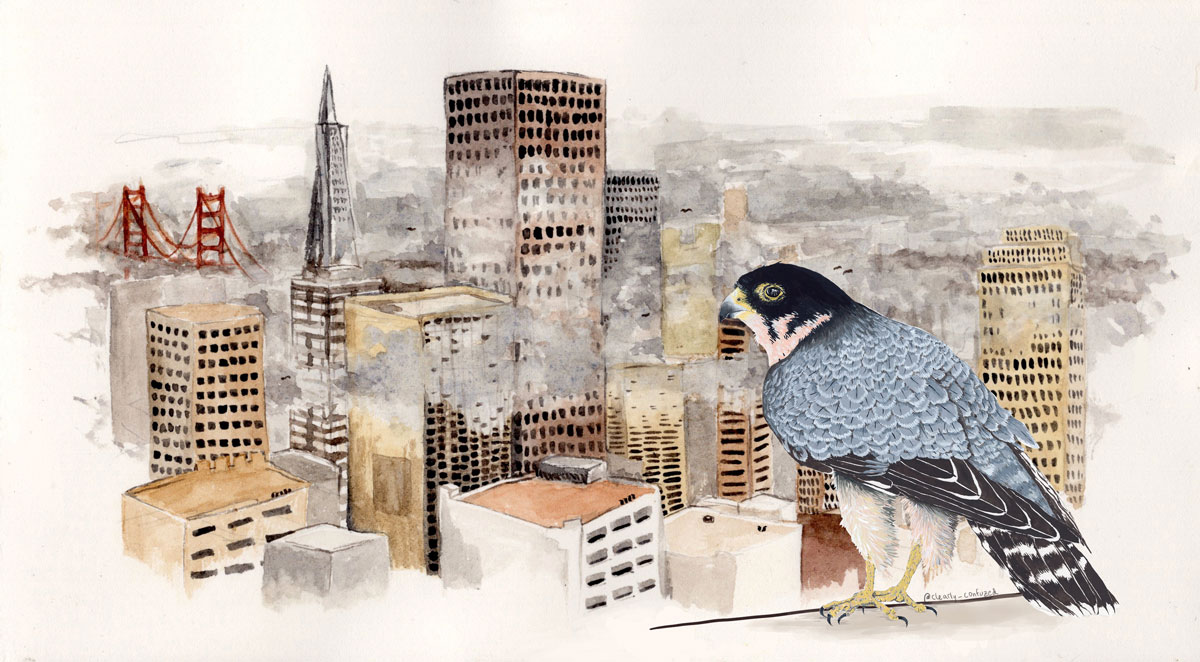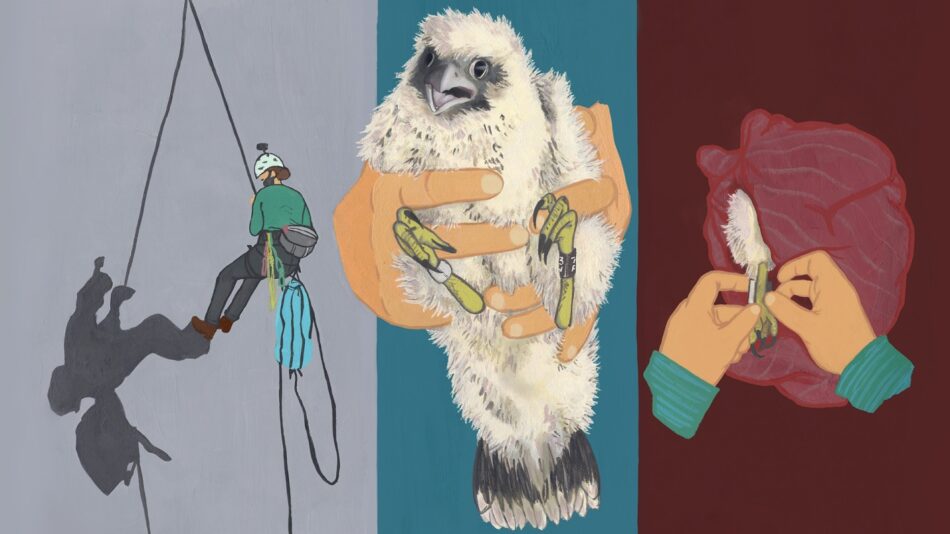Taking the pulse of peregrines
Peregrine falcons are back from the brink — and now they wear ID bands. Cypress Hansen explores what the San Francisco Bay Area’s peregrine population can tell us about urban ecosystems, raptor well-being, and community engagement. Illustrated by Josh Overington and Nayl Gonzalez.
Illustration: Josh Overington
Seventeen stories above a busy city street, a patient peregrine falcon named Grace faces the wan winter sun, warming her bird bones. She is huddled on a window sill on the southern face of a high-rise building in downtown San Jose. A male named Hopper circles in and joins her on the ledge. He expresses his fancy for Grace, a screeching ee-chup audible from half a block away.
Grace bobs her head and ruffles her feathers, raising her tail in the air. An invitation. Hopper spreads his wings and dives down several stories before slicing another circle in the air. Swooping up from below, he squawks and lands on her back, careful not to harm Grace with his talons as they do the deed. It’s January in the Bay Area and the 2020 peregrine falcon breeding season is underway.
As peregrine falcons continue to rebound from near extinction in the U.S., some have settled in the nation’s biggest cities, lured by abundant pigeon prey. This makes the peregrines easier to study, but the urban environment brings new threats to their survival. As predators at the top of the food chain, peregrines are constantly hunting, making them especially sensitive to contaminant accumulation, disturbance by humans, and changes in prey availability. Following the peregrine’s successful reintroduction to Central California in the 1990’s, the Predatory Bird Research Group at UC Santa Cruz has been monitoring the greater San Francisco Bay Area population for 20 years.
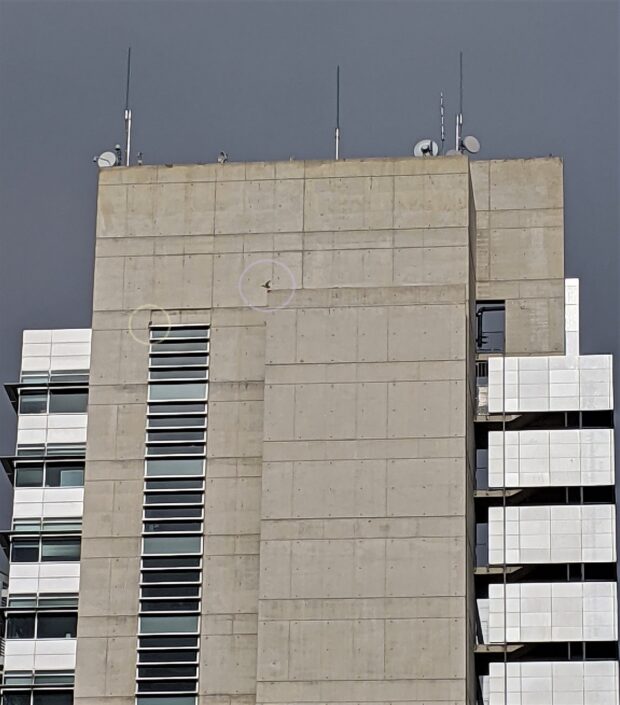
Grace (circled on left) looks on while Hopper II (right) dives from a ledge on the San Jose City Hall Building. (Cypress Hansen)
“We almost lost them and our community played a big role in bringing them back,” says Zeka Glucs, director of the Predatory Bird Research Group. “Our role is to keep an eye out for emerging issues with these birds, but also to be their their stewards, so they don’t have problems in the future.”
If a peregrine population starts tanking, that can mean something bigger is awry in the environment. “These birds are environmental sentinels,” says Chris McClure, director of global conservation at The Peregrine Fund in Boise, Idaho. McClure, who is not involved with the PBRG’s work, likens monitoring the Bay Area peregrines to keeping a smoke detector in the house. “We may not be detecting problems right now, but in case there is a problem, they’re going to be the first ones to tell you.”
“Welcome in the human landscape”
For thousands of years, peregrine falcons have been trained, persecuted, worshipped and driven nearly to extinction by humans. In his 1948 book Birds Over America, acclaimed ornithologist Roger Tory Peterson wrote, “Man has emerged from the shadows of antiquity with a peregrine on his wrist. Its dispassionate brown eyes, more than those of any other bird, have been witness to the struggle for civilization…” Today, those piercing eyes are the windows through which scientists peer to understand both wild and urban ecosystems.
Similar in size to a crow, these birds are agile, aerodynamic hunters built for speed. “If you see an adult peregrine, it’s pretty striking. It pops and you remember it,” McClure says. The bird’s hooked beak gleams bright yellow, as do its feet, which end in sharp, black talons. Blue-grey feathers along the wings and back culminate in a helmet-shape around its small head and large, dark eyes. Its cream-colored chin and neck are contrasted by narrow, black bars that run down its chest and legs.
Listed as federally endangered in 1970 and successfully removed from the list in 1999, peregrines represent one of the most notable rebound stories in the history of the U.S. Endangered Species Act. They are still riding the winds of recovery today, but many raptors around the world are not so fortunate. Dozens of species are still struggling with habitat loss, poaching, and disease. According to a 2018 study in Biological Conservation, of the 557 species of raptors worldwide, more than half were decreasing in number and nearly 20 percent were threatened with extinction. Long-term raptor monitoring projects are necessary for future conservation efforts to be appropriately designed and tested, the study’s authors wrote.
“Peregrines are one of the last wild predators to coexist with humans… Getting to watch them so intimately across the years is a privilege.”
Because peregrines patrol the skies of nearly every continent, they represent an excellent subject for such long-term studies since researchers can compare and apply how the birds fare across the various ecosystems falcons call home. “Peregrines are one of the last wild predators to coexist with humans,” says Glucs. “They can fly over walls and fences, they aren’t getting trapped and relocated like bears and mountain lions…they’re welcome here in the human landscape.”
By tracking the successes and failures of several generations of peregrines across a range of habitats in the Bay Area, Glucs hopes to learn about the food chains that support them, the contaminants that affect them, and other environmental issues they might alert her to. Peregrines can live up to twenty years, so trends may take time to show up in her data, but Glucs doesn’t see herself or her volunteers losing interest anytime soon. “I still get excited by the fact that they’re doing so well,” she says. “Getting to watch them so intimately across the years is a privilege.”
“Keeping peregrines on the planet”
By mid-March, Grace is back on her ledge of the San Jose City Hall, laying her rust-colored eggs. The process takes about a week, but before she bears her fourth and final egg, a new male, or tiercel, shows up ready to play house. Peregrines can mate for life, but some are more indiscriminate, especially in places with lots of mates to choose from like the Bay Area. Hopper—chased off by the newcomer—isn’t seen again, but for the sake of consistency, local bird-watchers name the new guy Hopper II. He immediately falls into a routine of incubating the eggs with Grace. It’s her first clutch as a new mom.
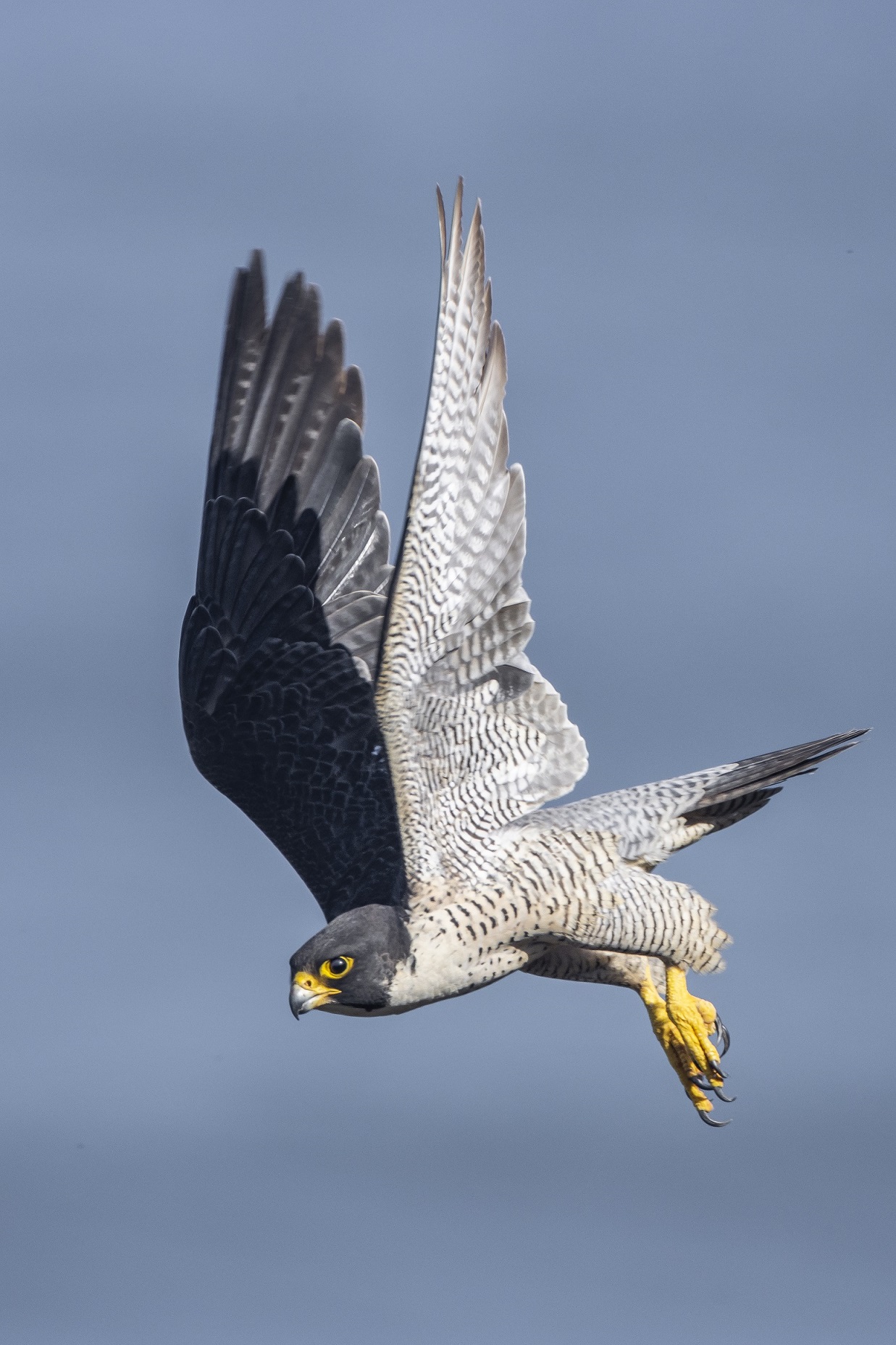
Peregrine falcons, with their unparalleled agility, speed, vision and strength, have captivated humans for millennia. (Andre Gregoire)
Grace, Hopper, and Hopper II belong to a group of approximately 200 breeding-age peregrine falcons in the greater San Francisco Bay Area. Luckily for Grace, suitors abound here, but finding a mate hasn’t always been easy for peregrines in North America. In 1970, a statewide survey of the California population counted a total of 11 birds, six of them without a partner. Other surveys repeatedly turned up zeros across the eastern U.S.
The peregrine falcon was one of several predatory bird species that dwindled to near extinction in North America as a result of habitat loss and DDT, a widely used pesticide that concentrated in predatory birds and caused eggshells to weaken and crack beneath incubating parents. Peregrines were added to the United States Endangered Species List in 1970, but it wasn’t until other declining species like the charismatic brown pelican and symbolic bald eagle caught the attention of the American public, that DDT was banned in 1972.
In 1975, peregrines reached their all-time low of just 324 breeding pairs across all of North America. That same year, the Predatory Bird Research Group began a peregrine reintroduction initiative in which students and faculty at UC Santa Cruz bred adults in captivity, artificially incubated wild eggs that were thinned by DDT, and fostered chicks into wild nests. Between 1975 and 1992, the PBRG released over 700 birds via “hack boxes” which allowed fledging chicks to transition smoothly into the wild environment.
At the time, “We were just focused on keeping the peregrine on the planet,” says Glenn Stewart, who began working with the PBRG as a student volunteer in 1976. In 2007, Stewart became director of the PBRG and decided to outfit as many peregrine chicks as possible with ID bands: little, metal anklets with a unique letter and number combination to help researchers follow the birds’ migrations, dispersal and breeding habits. Stewart estimates he banded around 250 peregrines over his decade-long tenure. “There are a lot of banded birds out there—people report sightings all the time,” he says.
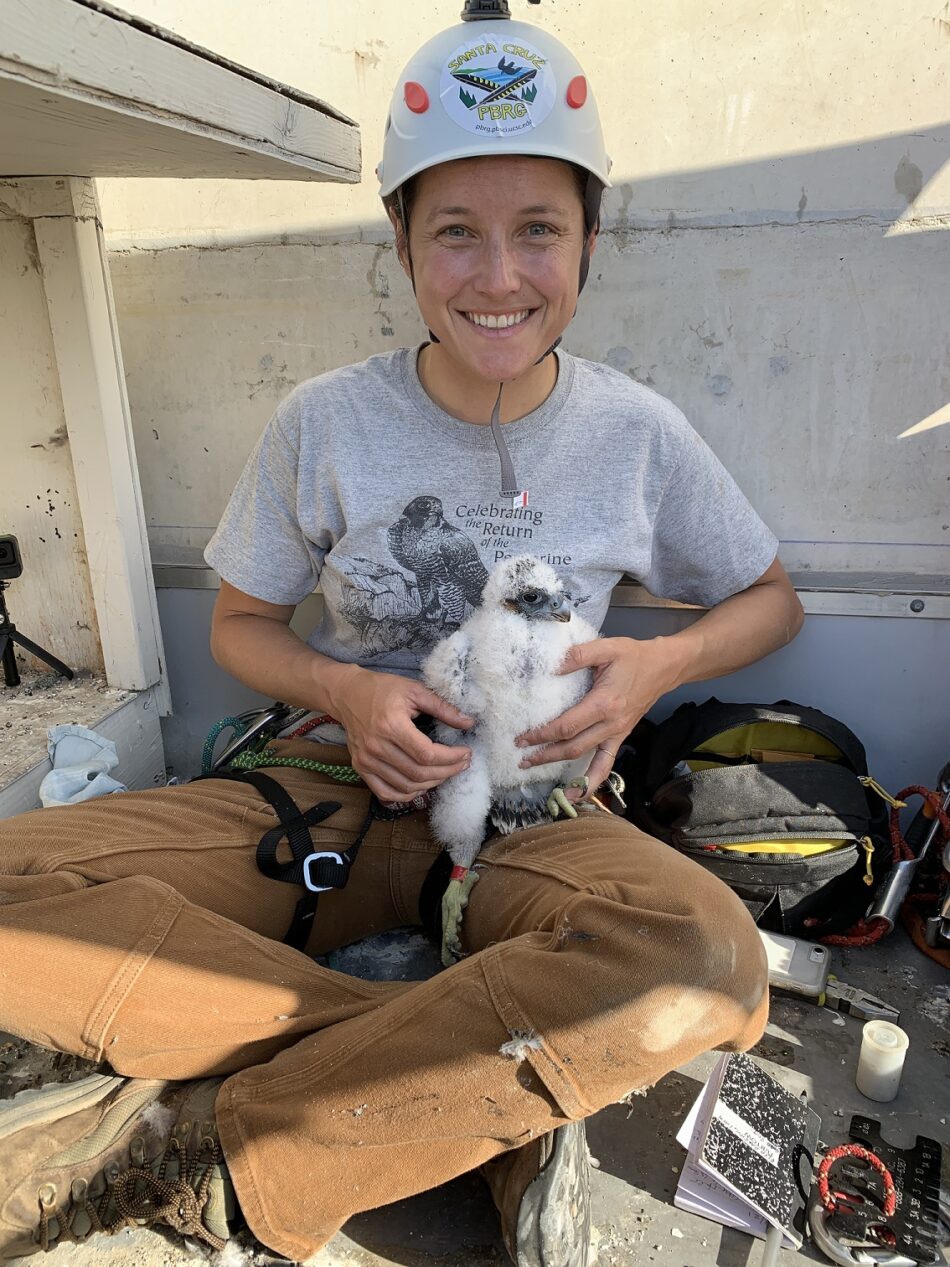
Glucs’ favorite part of raptor monitoring is performing nest entries to band the Bay Area’s next generation of falcons. (Gavin Emmons)
When Stewart retired in 2018, Glucs stepped in as director. A Santa Cruz native, she started out with the PBRG as a volunteer bird bander, using her rock climbing skills to scale buildings and bridges and rappel down cliffs to enter the falcons’ nests, also known as scrapes. Glucs says her first avian love (and subject of her PhD) is the California condor, but her eyes twinkle every time she talks about peregrines. “They’re slowly creeping in as my favorite California raptor,” she admits. “Peregrines are just so fun to watch… I’ve become addicted.”
“I see it in our banding data”
The most exciting time of year for Glucs is in late spring when the chicks, or eyasses, are nearly ready to fledge. By then the youngsters’ feet are nearly full grown, and it’s time to outfit their ankles with unique ID bands. To do this, Glucs must climb up or lower herself down to the precarious cliff-like locations where peregrines prefer to lay their eggs, such as high-rise rooftops, bridges, coastal bluffs, or water towers.
For one recent “nest entry,” Glucs — whose spritely stature seems perfect for the job — sported a harness, helmet and gloves while several bags of gear hung from her waist. She slowly rappelled downward from a high-rise roof to the scrape, nearly 200 feet off the ground. The intensity of the job keeps her attentive to every moment, she says. “It’s definitely a presence activator.”
The moment the fluffy, football-sized chicks spotted Glucs’ feet, they fired off a stream of frantic screeches, cowering inside their nest box. The parents, scared off initially, flew in tight circles overhead, shrieking. “Sometimes a parent will take a break, but the screams are usually pretty constant,” says Glucs. Fortunately for her, the adults can’t safely dive-bomb here, but at other more exposed sites, like the Moss Landing power plant towers or the roof of the UC Berkeley campanile, the adults have repeatedly “punched” Glucs, swooping in at high speeds and knocking her arms and helmet with their talons.
Once secure on the six-foot-wide ledge next to the nest box, Glucs laid out her tools: calipers, ankle sizer, pliers, crimpers, ankle bands, logbook. The chicks, quiet for a moment, looked on cautiously. Brushing past piles of bones, feathers and poop, Glucs gently grasped the first chick, set it in her lap — feet up — and covered its head with an old t-shirt to keep it calm.
Measure the ankle width. Record the ID numbers. Crimp on the metal bands. Release the chick. Within minutes, Glucs moved on to hatchling number two. “You’re trying to go as fast as possible; you don’t want to disturb them more than you have to,” she says. The chicks’ persistent parents were still loudly protesting when she packed her gear and pulled herself back up to the roof two stories above.
With each banded chick comes a new data point. Glucs’ project includes nesting sites across a range of habitat types around the San Francisco Bay including numerous traffic bridges, the bluffs above Muir beach, and the Financial District of San Francisco. Cities offer plentiful pigeon prey and tall, sturdy “cliffs” for the falcons to nest on. But they also present unique challenges. Last year, for instance, three banded birds were struck by airplanes or cars and two more crashed into buildings. As peregrines continue to expand into urban environments (a phenomenon undocumented in California prior to their reintroduction), Glucs says she’s “hoping to understand what additional risks peregrines are experiencing when they live in cities or near the coast.”
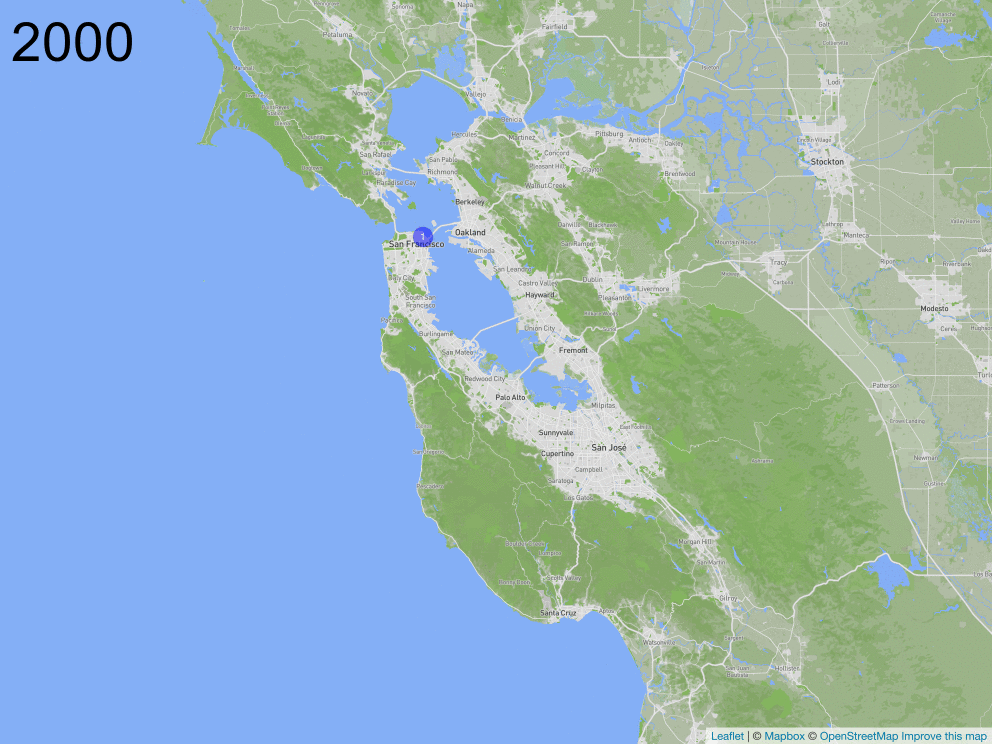
Twenty years of bird banding data from the San Francisco Bay Area, showing an increase in successful nesting sites. Circles indicate number of chicks banded at 21 days of age. Zeroes indicate nest failure. (Visualization by Cypress Hansen)
Glucs has also begun to collect feathers and blood samples from chicks, because she wants see if rising levels of environmental mercury are affecting peregrine populations. The toxic element is commonly found in marine ecosystems, as well as in Californian soils — a legacy of the 1890s Gold Rush — and can harm human and animal health. Glucs plans to compare mercury levels in California peregrines with those in Nevadan birds to see if their contaminated seabird prey has sub-lethal effects on reproduction and survival.
Over the past three years, Glucs has noticed shifting patterns in peregrine behavior, namely that the birds are laying eggs earlier and earlier in the season. “I see it in our banding data. We’re banding chicks earlier now than we were even a couple of years ago.” This is possibly due to shorter winters, Glucs says, but she’s worried that warmer winter months will be haunted by unpredictable cold snaps, which can leave parents scrambling to keep their eggs warm. Glucs is interested to see how the changing climate might affect some of the migratory residents she studies, such as one banded female that nests near Saratoga, but has been documented over 800 miles away in Baja California. “Their migrations and their breeding season are so dependent on the arrival of other birds and the emergence of prey species” in spring, she says. As those timelines change, the knife edge of survival may become harder for them to balance upon.
“People just adore these birds”
On May 1, 33 days after Grace and Hopper II began incubating their eggs together, a chick begins to hatch, right on schedule. Grace, who’s warming the eggs for the morning, looks down at the wobbling egg repeatedly, almost uncertain. With wings half spread, she stands and jumps to the ledge, screeching out over the city below. Hopper II lands on the scene in an instant, but doesn’t stay for long.
Grace returns to the eggs, shifting her weight from foot to foot, almost dancing with excitement. As the tiny chick rolls out of its shell, Grace gently nudges the white fuzzball back into the pile. She’s so careful not to step on the little eyas that she falls on her face several times as she maneuvers around the squirming newborn. Less than four minutes later, Hopper II returns, gripping a feathered meal in his talons.
Grace is incubating her clutch when the first chick hatches; she calls to Hopper II off camera. He tries to help by swiftly bringing home a meal, but Grace is busy tenderly caring for her newborn.
In 2007, nine years before Grace hatched from her own egg, thousands of viewers around the world tuned in to watch such tender moments via the PBRG’s first peregrine nest cam on the PG&E skyscraper in downtown San Francisco. Since the nest cam went live fourteen years ago, over 2 million viewers have swooned as tiercels quietly chirp at their eggs and laughed as awkward fledglings squabble over mom’s latest catch. The birds have cast a spell on everyone working inside the PG&E headquarters, from the customer care workers to the CEO, says PG&E’s spokeswoman, Jennifer Robison. Urban dwelling folks don’t often get to experience this “rare, close contact with truly wild nature,” she says. “People just adore these birds.”
Today, Grace and Hopper II’s nest box in San Jose is one of several nesting sites around the Bay Area that are streamed live, 24/7, year round, and in high definition. Alicia Lewis, a retired ICU nurse at the Stanford Medical Center, discovered the San Jose webcam on the news after it, too, was installed in 2007. She began tuning in from her office whenever she had downtime at the hospital. “You learn so much just by watching them,” she says.
Inspired by what she saw on the live stream, Lewis quickly signed up to volunteer for the PBRG. “I was able to calculate when the chicks were going to fledge and then I would take time off to volunteer,” she says. For over a decade, Lewis has planned her vacations around “fledge week.” She and her husband, John, are always onsite with binoculars, watching to make sure the chicks don’t run into trouble during their inaugural flights. Today, the Lewises watch four nest sites each spring to document the birds’ life stages and report their observations to Glucs. If fledglings land on the sidewalks below, they even help shuttle the youngsters back to their scrapes (Grace, who was born on the PG&E building, was one of those rescuees). “I see them like my patients,” says Lewis. “I’m watching them to make sure they’re doing okay… I do it because it gives them a second chance.”
A matter of ‘when’ not ‘if’
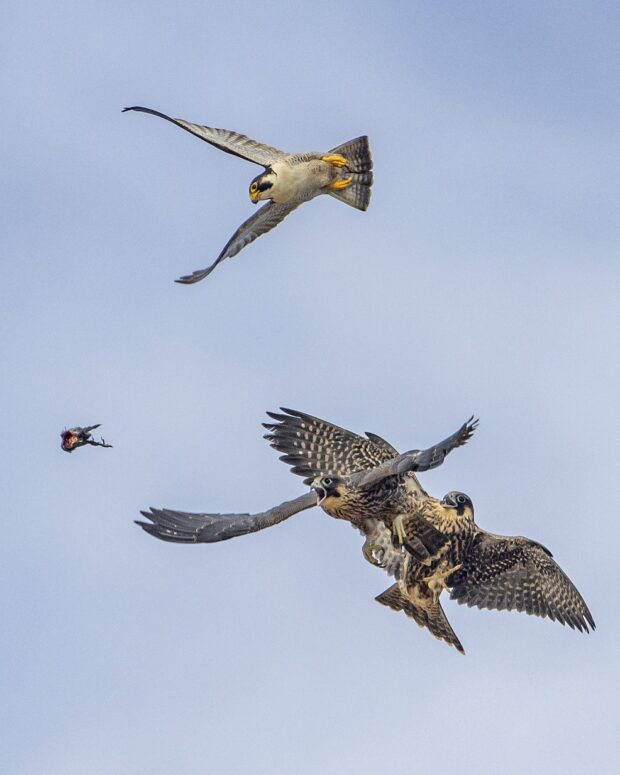
Once young peregrines fledge from the nest, they must learn how to hunt by practicing in mid-air with siblings (below) and parents (above). (Andre Gregoire)
By the first week of June, Grace’s four chicks are banded and almost ready to leave the nest. They are full size, but their messy brown feathers give away their youth. Fledging is the single greatest bottleneck for peregrine survival; sixty percent won’t make it past their first year. In the cities, a young bird might land on a busy road, fly into a building or power line, or get attacked by ravens or other raptors.
Just a few weeks after the youngsters take their shaky first flights, Yomele, one of the fledglings from Grace’s clutch, is found grounded with an injured wing, likely due to a collision. She’ll be in rehab for months and will hopefully be released in the next year. As for her three brothers, Dash, Julian and Guthrie, Glucs says they fledged well with no known issues. Not bad for the rookie parents; the average number of successful fledglings per nest is usually less than two.
Despite the help of faithful volunteers, there is no end to the pressures on peregrine survival. This year, new research suggests that persisting DDT in the ocean is linked to cancer in marine predators, while the Bay Area’s songbird population experienced a large outbreak of Salmonella. While Glucs hopes nothing serious will crop up for the chicks and grandchicks of Grace and Hopper II, she considers the next big threat a matter of ‘when’ not ‘if.’ The PBRG has dealt with near extinction before, but Glucs’ gaze into the dispassionate brown eyes of North America’s most accessible predator must remain unbroken to ensure that chapter of the story remains a thing of the past.

Cypress Hansen
Author
B.S. Marine Science, Eckerd College
Internships: Santa Cruz Sentinel, Knowable Magazine, Lookout Local, Smithsonian Voices
On a first-grade field trip to the state anthropology museum, I relished learning how the native tribes of Arizona farmed, irrigated and foraged for food. Every time the presenters asked my class a question, my hand shot up with an answer. Yes, I was that kid. Edging forward in my seat, I was eager to carry on the conversation, certain that what I had to say would bring us closer to the truth.
Thankfully, I have since learned that I don’t have all the answers. However, I am still determined to share science and keep dialogue and discussion alive.
As a science communicator, I want the world to see science as an ever-evolving and humbling endeavor that—like a passionate child—is just trying to bring us closer to truth.
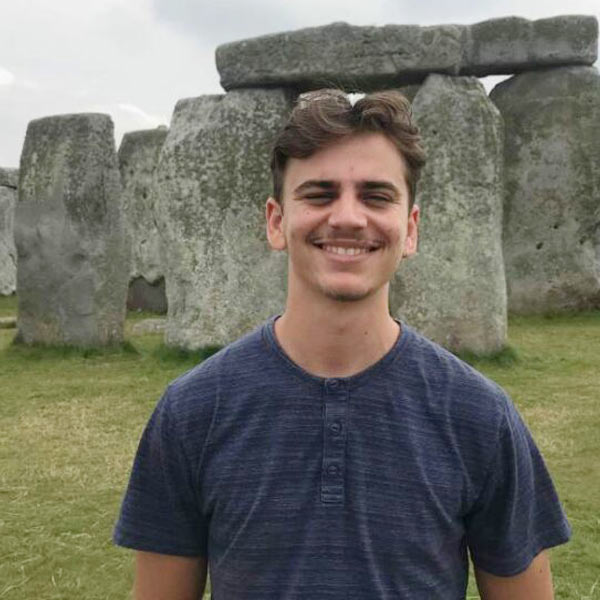
Josh Overington
Illustrator
B.A. Environmental Education and Interpretation, Humboldt State University
Joshua Overington is a scientific illustrator and interpretive designer based out of California. He uses his art to foster a love for the natural world and its many beautiful intricacies. He is, as we all are, clearly confused, and finds solace in creating beauty and bringing joy through art.
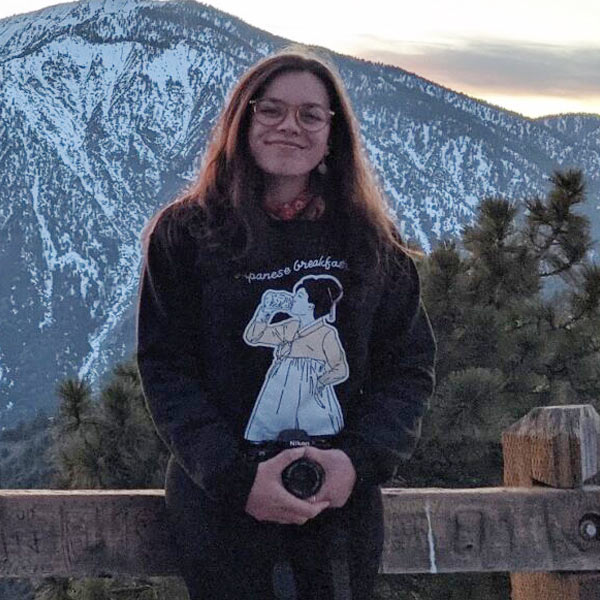
Nayl Gonzalez
Illustrator
B.S. Forestry and Natural Resources, Cal Poly San Luis Obispo
Nayl Gonzalez is a creative currently based out of Penngrove, California. Nayl has a bachelor’s degree in Forestry and Natural Resources with concentrations in Indigenous Studies and Wildlife Biology from Cal Poly San Luis Obispo. During her time there she had many opportunities to hike, camp, explore, and illustrate and share science with others. Inspired by the natural world and fueled with the desire to help make science more accessible, she now strives to create illustrations and graphics that influence all generations to get excited about learning.
